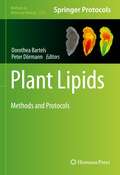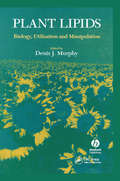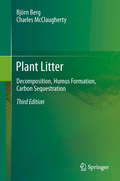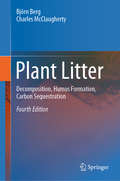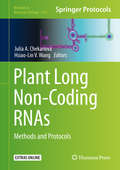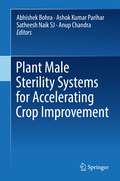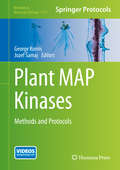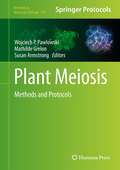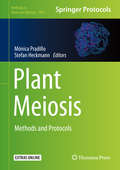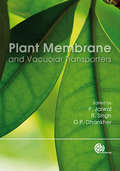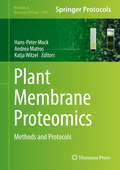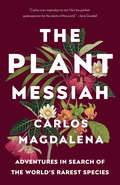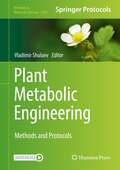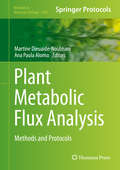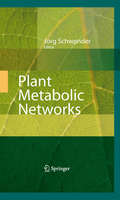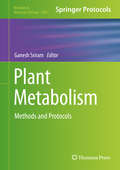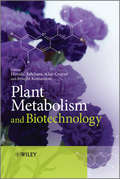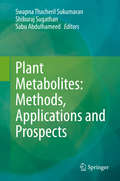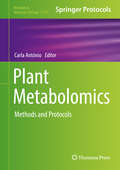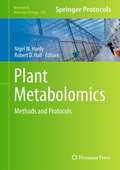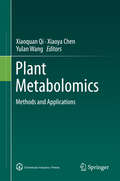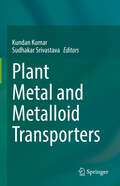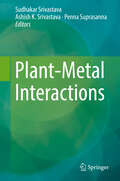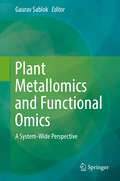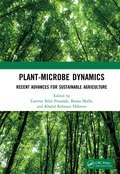- Table View
- List View
Plant Lipids: Methods and Protocols (Methods in Molecular Biology #2295)
by Dorothea Bartels Peter DörmannThis volume explores analytical methods to study complex lipid mixtures from plants and algae. The chapters in this book are organized into five parts and cover topics such as basic methods of lipid isolation and analysis; mass spectrometry and NMR analysis; lipid isolation and analysis from plant tissues, cell compartments and organelles; lipid signaling, lipid-protein interactions, and imaging; and lipid databases. Written in the highly successful Methods in Molecular Biology series format, chapters include introductions to their respective topics, lists of the necessary materials and reagents, step-by-step, readily reproducible laboratory protocols, and tips on troubleshooting and avoiding known pitfalls.Cutting-edge and comprehensive, Plant Lipids: Methods and Protocols is a valuable guide for experienced researchers and undergraduate, graduate, and Ph.D. students. This book is also an excellent resource for novice scientists with little to no experience in lipid experiments who are interested in approaching this field experimentally.
Plant Lipids: Biology, Utilisation and Manipulation (Biological Sciences Ser.)
by Denis J. MurphyNew research tools have revealed many surprising aspects of the dynamic nature of lipids and their participation in processes such as recognition, intra- and inter-cellular signalling, deterrence and defense against pathogens, membrane trafficking and protein function. This is in addition to new information on the more established roles of plant lipids as structural components of membranes and as long-term storage products. Plant lipids are also increasingly being seen as sources of a new generation of environmentally friendly, biodegradable, and renewable industrial products, including biopolymers and high-grade lubricants.Plant Lipids: Biology, Utilisation and Manipulation provides a broad overview of plant lipid research and its many applications. Linking various disciplines, the editor brings together researchers from major international laboratories to review the history and current state of progress in this quickly evolving field. The text starts by providing a fascinating historical perspective on the study of plant lipids, from its inception as a branch of alchemy in the seventeenth century to the current post-genomic era. It then offers a detailed discussion on the formation, modification and utilization of fatty acids. This is followed by an exploration of the major classes of macromolecular structures formed by plant lipids, including bilayer membranes and storage bodies. From there, the contributors consider other types of macromolecular lipid assemblies in plants, examining proteins and the key plant lipid structure - the cuticle. The final chapters look at diverse classes of plant lipids that are linked to various aspects of signaling. This text provides an excellent resource for researchers and professionals in plant biochemistry, molecular biology, biotechnology and genetics, in both the academic and industrial sectors. It also meets the needs of students looking for a comprehensive introduction to this field, as well as direction for fut
Plant Litter
by Björn Berg Charles McclaughertySince the publication of the 2nd edition, there have been substantial developments in the field of litter decomposition. This fully revised and updated 3rd edition of Plant Litter reflects and discusses new findings and re-evaluates earlier ones in light of recent research and with regard to current areas of investigation. The availability of several long-term studies allows a more in-depth approach to decomposition patterns and to the later stages of decomposition, as well as to humus formation and accumulation. The latest information focuses on three fields: - the effects of manganese on decomposition and possibly on carbon sequestration, - new findings on decomposition dynamics, and - the new analytical technique using 13C-NMR.
Plant Litter: Decomposition, Humus Formation, Carbon Sequestration
by Björn Berg Charles McClaughertyThis book gives basic facts about litter decomposition studies, which are of guidance for scientists who start studies. Since the publication of the third edition, there has been quite a development not only in the field of litter decomposition but also in supporting branches of science, which are important for fruitful work on and understanding of decomposition of plant litter and sequestration of carbon. A consequence is that ‘old established truths’ are becoming outdated. New knowledge in the fields of phytochemistry and microbial ecology has given a new baseline for discussing the concepts ‘litter decomposition’ and ‘carbon sequestration’. We can also see a rich literature on litter decomposition studies using roots and wood as substrates. These have given new insights in factors that regulate the decomposition rate and as regards roots their contribution to sequestered carbon in humus. Additional facts on the role of temperature vs the litters’ chemical composition may in part change our view on effects of climate change. Further information on applications of the new analytical technique (13C-NMR) for determining organic-chemical compounds has allowed us to develop these parts. Focus is laid on needle litter of Scots pine as a model substrate as this species has been considerably more studied than other litter species. Also the boreal/northern temperate coniferous forest has in part been given this role. Still, new information may allow us to develop information about litter from further tree species.
Plant Long Non-Coding RNAs: Methods and Protocols (Methods in Molecular Biology #1933)
by Julia A. Chekanova Hsiao-Lin V. WangThis volume focuses on various approaches to studying long non-coding RNAs (lncRNAs), including techniques for finding lncRNAs, localization, and observing their functions. The chapters in this book cover how to catalog lncRNAs in various plant species; determining subcellular localization; protein interactions; structures; and RNA modifications. Written in the highly successful Methods in Molecular Biology series format, chapters include introductions to their respective topics, lists of the necessary materials and reagents, step-by-step, readily reproducible laboratory protocols, and tips on troubleshooting and avoiding known pitfalls.Cutting-edge and innovative, Plant Long Non-Coding RNAs: Methods and Protocols is a valuable resource that aids researchers in understanding the functions of lncRNAs in different plant species, and helps them explore currently uncharted facets of plant biology.
Plant Male Sterility Systems for Accelerating Crop Improvement
by Abhishek Bohra Ashok Kumar Parihar Satheesh Naik Sj Anup ChandraThis book covers all aspects of hybrid breeding technologies applied for crop improvement in major field crops. The different male sterility systems such as genetic male sterility (GMS), cytoplasmic male sterility (CMS), cytoplasmic and genetic male sterility (CGMS), and male sterility induced by the photoperiod (PGMS), temperature (TGMS), and chemicals are discussed in detail. The different chapters in this book provide a timeline of the key breakthroughs witnessed in the field of plant male sterility technologies, their application in hybrid breeding, and the relevance to the current need for food security. In-depth insights into the genetic and regulatory mechanisms of plant male sterility have been presented. This includes discussion on a variety of molecular players that induce male sterility and rescue male fertility in the hybrid plants. To enhance this book’s appeal, more emphasis has been given on the modern emerging approaches such as construction of heterotic pools that could boost hybrid breeding for enhanced crop performance amid climate change and growing population worldwide. This book is a guide for growers and industries related to field and horticultural crops. Further, it is a useful reference for plant breeders, researchers and extension workers, and students. The material can also be used for teaching undergraduate and postgraduate courses.
Plant MAP Kinases
by George Komis Jozef ŠamajMitogen-activated protein kinases (MAPKs) are versatile phosphorylating enzymes which regulate multiple proteins involved in gene expression, cell architecture, plant development and reaction to diverse abiotic and biotic factors. The main aim of Plant MAP Kinases: Methods and Protocols is to provide established and new MAPK protocols adapted to the challenges posed by working with plants. The book contains 19 chapters which encompass a wide array of methods progressively scaling from the single gene, protein or cell level to large-scale arrays of proteomic, phosphoproteomic and interactomic data in order to uncover previously unidentified plant MAPK signaling pathways and to tackle with the challenging task of substrate identification. Techniques for MAPK sequence analysis and subcellular localization helping to identify their substrates and subcellular compartmentalization are also provided. Written in the highly successful Methods in Molecular Biology series format, chapters include introductions to their respective topics, lists of the necessary materials and reagents, step-by-step, readily reproducible laboratory protocols, and key tips on troubleshooting and avoiding known pitfalls. Authoritative and practical, Plant MAP Kinases: Methods and Protocols represents a collection of useful plant MAPK protocols written by experts in the field for researchers and students.
Plant Meiosis
by Wojciech P. Pawlowski Susan Armstrong Mathilde GrelonMeiosis is one of the most critical processes in eukaryotes, required for continuation of species and generation of new variation. In plants, meiotic recombination is by far the most important source of genetic variation. In Plant Meiosis: Methods and Protocols, expert researchers in the field detail methods for molecular cytogenetics and chromosome analysis in plants. These state-of -the-art protocols allow studying the organization and behavior of the genetic material in a wide range of both model and crop species. Written in the highly successful Methods in Molecular BiologyTMseries format, chapters include introductions to their respective topics, lists of the necessary materials and reagents, step-by-step and readily reproducible laboratory protocols, and key tips on troubleshooting and avoiding known pitfalls. Authoritative and practical, Plant Meiosis: Methods and Protocols provides and extensive list of protocols developed and used in a number of laboratories at the cutting edge of meiosis and chromosome research.
Plant Meiosis: Methods and Protocols (Methods in Molecular Biology #2061)
by Mónica Pradillo Stefan HeckmannThis volume looks at the latest techniques used by the meiosis research community to study plant meiosis. The chapters in this book are organized into four parts: Part One discusses cytological and imaging approaches to study meiosis and chromosome dynamics in Arabidopsis (in both diploid and polyploid backgrounds); Part Two talks about using cytological methods to study meiosis in other plant species; Part Three focuses on molecular and biochemical approaches to look at plant meiosis; and Part Four explores further procedures and experiments that are helpful in learning more about plant meiosis. Written in the highly successful Methods in Molecular Biology series format, chapters include introductions to their respective topics, lists of the necessary materials and reagents, step-by-step, readily reproducible laboratory protocols, and tips on troubleshooting and avoiding known pitfalls.Thorough and cutting-edge, Plant Meiosis: Methods and Protocols is a valuable resource for both novice and expert researchers who are interested in learning more about this developing field.
Plant Membrane and Vacuolar Transporters
by Om Parkash Dhankher Rana P. Singh Pawan K. JaiwalBased on current research in genomics and proteomics, this book clarifies the identification and characterization of plant membrane and vacuolar transporters.
Plant Membrane Proteomics
by Hans-Peter Mock Andrea Matros Katja WitzelThis volume provides comprehensive and detailed protocols that discuss proteomic techniques, plant endosomes, and isolation of organelles and subcellular fractions. The chapters in this book explore numerous plant species and cover topics, such as isolation and purity assessment of membranes from Norway spruce; proteomic analysis of nuclei; analyzing the vacuolar membrane (tonoplast) proteome; isoforms of a thylakoid-bound protein; assay of plasma membrane H+-ATPase in plant tissue under abiotic stresses; and identification and characterization of plant membrane proteins using ARAMEMNON. Written in the highly successful Methods in Molecular Biology series format, chapters include introductions to their respective topics, lists of the necessary materials and reagents, step-by-step, readily reproducible laboratory protocols, and tips on troubleshooting and avoiding known pitfalls. Practical and thorough, Plant Membrane Proteomics: Methods and Protocols is a valuable resource that promotes the use of plant membrane proteomics to develop the future of the field.
The Plant Messiah: Adventures in Search of the World's Rarest Species
by Carlos MagdalenaAn impassioned memoir of saving extraordinary plants on the brink of extinction, by a scientist who has been called a "codebreaker" (Telegraph) and "an inspiration" (Jane Goodall)Carlos Magdalena is not your average horticulturist. He's a man on a mission to save the world's most endangered plants. First captivated by the flora of his native Spain, he has travelled to the remotest parts of the globe in search of exotic species. Renowned for his pioneering work, he has committed his life to protecting plants from man-made ecological destruction and thieves hunting for wealthy collectors.In The Plant Messiah, Magdalena takes readers from the Amazon to the jungles of Mauritius to deep within the Australian Outback in search of the rare and the vulnerable. Back in the lab, we watch as he develops groundbreaking, left-field techniques for rescuing species from extinction, encouraging them to propagate and thrive once again. Along the way, he offers moving, heartfelt stories about the secrets contained within these incredible organisms. Passionate and absorbing, The Plant Messiah is a tribute to the diversity of life on our planet, and the importance of preserving it.*Featuring 16 pages of color photos*
Plant Metabolic Engineering: Methods and Protocols (Methods in Molecular Biology #2396)
by Vladimir ShulaevThis volume looks at the latest techniques used by researchers to study various aspects of plant metabolic engineering. The chapters in this book cover topics such as bioinformatics tools used to discover new genes and pathways; heterologous expression of biosynthetic genes in plant and microbial systems; and omics technologies, such as transcriptomics, proteomics, metabolomics, and data analysis. Written in the highly successful Methods in Molecular Biology series format, chapters include introductions to their respective topics, lists of the necessary materials and reagents, step-by-step, readily reproducible laboratory protocols, and tips on troubleshooting and avoiding known pitfalls. Cutting-edge and comprehensive, Plant Metabolic Engineering: Methods and Protocols is a valuable resource for biologists, chemists, biotechnologists, students, and broad cohorts of researchers who works in the fields of plant metabolism and metabolic engineering.
Plant Metabolic Flux Analysis
by Martine Dieuaide-Noubhani Ana Paula AlonsoIn "Plant Metabolic Flux Analysis," expert researchers in the field provide detailed experimental procedures for each step of the flux quantification workflow. Steady state and dynamic modeling are considered, as well as recent developments for the reconstruction of metabolic networks and for a predictive modeling. Written in the highly successful "Methods in Molecular Biology "series format, chapters include introductions to their respective topics, lists of the necessary materials and reagents, step-by-step, readily reproducible laboratory protocols and key tips on troubleshooting and avoiding known pitfalls. Authoritative and practical" Plant Metabolic Flux Analysis," seeks to aid scientists in the further study of cutting-edge protocols and methodologies that are crucial to getting ahead in MFA.
Plant Metabolic Networks
by Jacqueline V. Shanks Jörg SchwenderPlants are the basis for human nutrition and of increasing interest for the chemical industry as a source of chemical feed stocks. Fuels derived from plant biomass will increasingly replace fossil fuels in the future. In order to increase crop productivity, design new plant products, and create new energy crops, there is need for methods of qualitative and quantitative analysis of metabolism which are able to guide the rational re-design of metabolic networks. In this book, recent advances in qualitative and quantitative analysis of metabolism are summarized to give an overview of the current state of knowledge. Principles of the analysis of network structure, flux analysis, and kinetic modeling are described. Analytical methods necessary to produce the data needed for metabolic flux analysis and for kinetic modeling are described. The analysis of larger metabolic networks is only possible by using computer assistance. Therefore each chapter of the book shall also describe software available for this purpose.
Plant Metabolism
by Ganesh SriramIn Plant Metabolism: Methods and Protocols, expert researchers in the field present the latest methods on quantitative analysis of plant metabolism. The methods focus on measurements, analyses and simulations of molecules, fluxes, and ultimately entire metabolic pathways and networks. Written in the highly successful Methods in Molecular Biology series format, chapters include introductions to their respective topics, lists of the necessary materials, reagents, or software, step-by-step, readily reproducible laboratory protocols, and key tips on troubleshooting and avoiding known pitfalls. Authoritative and practical, Plant Metabolism: Methods and Protocols seeks to benefit scientists ranging from plant biology, metabolic engineering, and biotechnology.
Plant Metabolism and Biotechnology
by Alan Crozier Hiroshi Ashihara Atsushi KomamineVarious plant metabolites are useful for human life, and the induction and reduction of these metabolites using modern biotechnical technique is of enormous potential important especially in the fields of agriculture and health. Plant Metabolism and Biotechnology describes the biosynthetic pathways of plant metabolites, their function in plants, and some applications for biotechnology. Topics covered include: biosynthesis and metabolism of starch and sugarslipid biosynthesissymbiotic nitrogen fixationsulfur metabolismnucleotide metabolismpurine alkaloid metabolismnicotine biosynthesisterpenoid biosynthesisbenzylisoquinoline alkaloid biosynthesismonoterpenoid indole alkaloid biosynthesisflavonoid biosynthesispigment biosynthesis: anthocyanins, betacyanins and carotenoidsmetabolomics in biotechnologyPlant Metabolism and Biotechnology is an essential guide to this important field for researchers and students of biochemistry, plant biology, metabolic engineering, biotechnology, food science, agriculture, and medicine.
Plant Metabolites: Methods, Applications and Prospects
by Swapna Thacheril Sukumaran Shiburaj Sugathan Sabu AbdulhameedFood security and the medicinal needs of billions of people around the world are pressing global issues, and the biodiversity and sustainable utilization of plants is of great significance in this context. Further, ethnobotanical studies are vital in the discovery of new drugs from indigenous medicinal plants, and plants with industrially important metabolites need to be cultivated to meet the growing market demand. In addition, the production of plant metabolites under in vitro conditions also has tremendous possibilities. The totipotency of plant cells plays a valuable role in the sustainable utilization of plant resources through cell, tissue and organ culture. At the same time, production can be enhanced using productive cell lines, treatment with elicitors, changing nutritional parameters and metabolic engineering. This book provides state-of-the-art information on biodiversity, conservation, ethnobotany, various aspects of In vitro secondary metabolite production, bioprospecting from various plant groups and drug discovery. It also discusses methods of extracting and characterizing drug leads from plant sources.
Plant Metabolomics: Methods and Protocols (Methods in Molecular Biology #1778)
by Carla AntónioThis detailed book aims to address the need for standardizing key steps in plant metabolomics research that is still considered a critical issue in the field. The collection unites diverse mass spectrometry (MS)-based protocols, from sample preparation and extraction of plant primary and secondary metabolites (e.g. a range of sugars, lipids, phytohormones and volatile organic compounds) to metabolite analysis, using exclusively highly sensitive MS-based methodologies, followed by frontline bioinformatics and/or mathematical modeling approaches to produce reliable biological data interpretation. Written for the highly successful Methods in Molecular Biology series, chapters include introductions to their respective topics, lists of the necessary materials and reagents, step-by-step, readily reproducible laboratory protocols, and tips on troubleshooting and avoiding known pitfalls. Authoritative and practical, Plant Metabolomics: Methods and Protocols serves both new and well-established researchers in the plant metabolomics field in finding helpful guidelines and useful laboratory-based protocols for setting up their routine plant metabolomics experiments.
Plant Metabolomics
by Nigel W. Hardy Robert D. HallEstimation of the metabolite complement of plant material involves a wide range of techniques and technologies and that breadth continues to increase. Metabolomics research typically involves multiple sites for material preparation and analysis and most investigations are "high throughput", meaning that chemical analysis of sample sets are inevitably carried out over an extended period of time. In, Plant Metabolomics: Methods and Protocols expert researchers in the field detail many of the stages which are now commonly used to study plant metabolomics workflow. Stages of this workflow, up to and including the statistical analysis, accurate and detailed collection of meta-data are also essential for good process management, to satisfy reporting requirements and to ensure wider interpretability and reuse results.Written in the highly successful Methods in Molecular BiologyTM series format, chapters include introductions to their respective topics, lists of the necessary materials and reagents, step-by-step, readily reproducible laboratory protocols, and key tips on troubleshooting and avoiding known pitfalls. Through and intuitive Plant Metabolomics: Methods and Protocols, seeks to aid scientists in the further study of the methods for all the stages of the plant metabolomics workflow.
Plant Metabolomics
by Xiaoquan Qi Xiaoya Chen Yulan WangThis book introduces plant metabolomics, an experimental approach that is important in both functional genomics and systems biology. It can be argued that metabolite data is most closely linked to phenotypes and that changes in metabolite content or metabolic networks can therefore indicate gene function more directly than mRNA transcript or protein based-approaches. Additionally, the identification of metabolic markers has important applications in plant breeding. The book, written by researchers who are active in plant metabolomics in China, not only introduces the fundamental concepts and the latest methodological advances in the field of plant metabolomics, but also details new studies from the respective scientific programs of the authors and thus reflects the current state of domestic plant metabolomics research. Professor Xiaoquan Qi is the principal investigator at the Institute of Botany, CAS. Professor Xiaoya Chen is a member of the Chinese Academy of Science and also is the principal investigator at the Shanghai Institutes for Biological Sciences, CAS. Professor Yulan Wang is leading a team in BioSpectroscopy and Metabolomics at the Wuhan Institute of Physics and Mathematics, CAS.
Plant Metal and Metalloid Transporters
by Kundan Kumar Sudhakar SrivastavaThis edited book stands as a one place knowledge hub for plant metal(loid) transporters. The book comprehensively covers holistic aspect of metal(loid) transporters involved in uptake and translocation of essential as well as toxic metal(loid)s. Essential and beneficial metal(loid)s are required in every biological process for normal plant growth and development, however in excess they are toxic. There are toxic metal(loid)s also whose accumulation in plants interferes with normal cellular functioning and hampers growth of plants. Hence, metal(loid) uptake and accumulation in plants is a highly regulated phenomenon involving the role of several transporters, enzymes, metabolites, transcription factors and post translational modifications. The book contains chapters from the experts and the contents of the book are presented in simple language and represented through beautiful and scientifically informative figures and tables. This book is of interest to teachers, researchers, doctoral and graduate students working in the area of plant physiology, environmental biotechnology, plant biotechnology metal(loid) stress, phytoremediation and crop biofortification.
Plant-Metal Interactions
by Sudhakar Srivastava Ashish K. Srivastava Penna SuprasannaMetal toxicity and deficiency are both common abiotic problems faced by plants. While metal contamination around the world is a critical issue, the bioavailability of some essential metals like zinc (Zn) and selenium (Se) can be seriously low in other locations. The list of metals spread in high concentrations in soil, water and air includes several toxic as well as essential elements, such as arsenic (As), cadmium (Cd), chromium (Cr), aluminum (Al), and selenium (Se). The problems for some metals are geographically confined, while for others, they are widespread. For instance, arsenic is an important toxic metalloid whose contamination in Southeast Asia and other parts of world is well documented. Its threats to human health via food consumption have generated immense interest in understanding plants’ responses to arsenic stress. Metals constitute crucial components of key enzymes and proteins in plants. They are important for the proper growth and development of plants. In turn, plants serve as sources of essential elements for humans and animals. Studies of their physiological effects on plants metabolism have led to the identification of crucial genes and proteins controlling metal uptake and transport, as well as the sensing and signaling of metal stresses. Plant-Metal Interactions sheds light on the latest development and research in analytical biology with respect to plant physiology. More importantly, it showcases the positive and negative impacts of metals on crop plants growth and productivity.
Plant Metallomics and Functional Omics: A System-Wide Perspective
by Gaurav SablokMajor portion of the planet earth is covered by seas and oceans representing 96.5% of the planet’s water, playing a detrimental role in sustaining the plant including crop diversity and productivity for human consumption. Water resources contain both soluble and transition metals, which are easily absorbed by plants through roots as a first point of contact and subsequently play important physiological and biological functions in plants. Transition metals such as copper (Cu), iron (Fe), manganese (Mn) and zinc (Zn) contribute to the plant productivity by playing key functional roles in the photosynthesis. In addition, to their major role in regulating the plant productivity, they also play an important role by acting as homeostatic regulators in uni-parentally inherited chloroplasts and maintains the flow of the electron transfer. It is worthwhile to mention that they play a critical role as transporters, which acts as electron balancing units for managing the electrostatic potential across the membranes. In contrast, some metals such as Cd, As play a significant role in inducing the stress mechanism and influencing either directly or in-directly Haber-Weiss reactions either through the production of the reactive oxygen species (ROS) or through the membrane damage thus leading to leakage of membrane transporters. However, besides playing a detrimental role as transporters in plant system, excessive accumulation of these metals due to the increasing contamination in the marginal soil and water are posing important threats to the plant system. Realizing the toxic effects of the metals, several physiological evidences have been laid for the credence of the metal toxicity and their concurrent effect on plant productivity. Increasing effects of the metals as toxicants can have three adverse effects on the populations: population can move, persist via local adaptation or phenotypic plasticity, or die. Next generation sequencing studies have revolutionized our abilities to detect the changes in expression profiles across an array of genes, which can in-turn help to develop early markers of metal induced stress. Plant Metallomics and Functional Omics: A System-Wide Perspective focuses on the applications of the system wide understanding of the biological and functional interplay occurring at the juncture of the metalloid induced stress and toxicity. The main goal of this book is to familiarize the readers with the most up-to-date information on metal-induced physiological changes in plant species.
Plant-Microbe Dynamics: Recent Advances for Sustainable Agriculture
by Tanveer Bilal PirzadahPlants and microbes have co-evolved and interacted with each other in nature. Understanding the complex nature of the plant-microbe interface can pave the way for novel strategies to improve plant productivity in an eco-friendly manner. The microbes associated with plants, often called plant microbiota, are an integral part of plant life. The significance of the plant microbiome is a reliable approach toward sustainability to meet future food crises and rejuvenate soil health. Profiling plant-associate microbiomes (genome assemblies of all microbes) is an emerging concept in understanding plant-microbe interactions. Microbiota extends the plant capacity to acclimatize fluctuating environmental conditions through several mechanisms. Thus, unraveling the mystery of plant-microbe dynamics through latest technologies to better understand the role of metabolites and signal pathway mechanisms is very important. This book shares the latest insight on omics technologies to unravel plant-microbe dynamic interactions and other novel phytotechnologies for cleaning contaminated soils. Besides, it also provides brief insight on the recently discovered clustered regularly interspaced short palindromic repeats CRISPR-Cas9, which is a genome editing tool to explore plant-microbe interactions and how this genome editing tool helps to improve the ability of microbes/plants to combat abiotic/biotic stresses.
